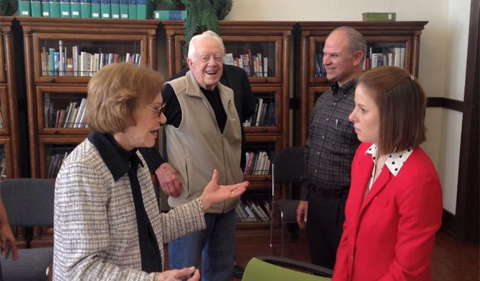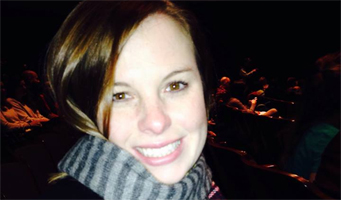
History graduate student Eryn Kane (in red) talks with Rosalynn Carter, as President Carter looks on. Photo credit: National Parks Services and Jimmy Carter National History Site.
Eryn Kane, Ph.D. student in the History Department, was recently invited to the Jimmy Carter National Historic Site, where she participated in a roundtable and helped advise on updating the site, including giving more attention to Rosalynn Carter.
The visit was sponsored by the U.S. National Parks Service and the Jimmy Carter National Historic Site in Plains, GA, and both were keen on Kane and other historians’ insights as the parks service is updating the museum at the Jimmy Carter National Historic Site.
Kane participated in a historians’ roundtable, where a select group of scholars shared their expertise regarding the former president and first lady. Other roundtable invitees included Dr. D. Jason Berggren of Georgia Southwestern University, Dr. Adrienne Petty of City University of New York, Dr. Robert Strong of Washington and Lee University, Dr. E. Stanly Godbold, Jr., Emeritus of Mississippi State, and Dr. Steven Hochman from the Carter Center. The roundtable discussion were recorded over a three-day period and will be used in the development of new exhibits at the site
Kane began her participation in the roundtable with a presentation on Mrs. Carter’s role as first lady. She argued that Jimmy and Rosalynn Carter were political partners—a relationship that developed long before they entered the White House in 1977. The close connection between the President and First Lady are attributed to a combination of factors: Southern cultural traditions, family dynamics, and business practices. She was asked to provide additional insights and information regarding Rosalynn’s childhood in Plains, views on civil rights, perception in the mass media, and overall legacy.
One of Kane’s central recommendations was that the new exhibits need to provide equal attention to Rosalynn Carter, as she is President Carter’s “equal partner” both in life and in the White House.
Mrs. President?
Kane’s invitation was prompted by her recent publication, “Mrs. President?,” appearing in Wiley-Blackwell’s A Companion to Gerald R. Ford and Jimmy Carter. Therein, she assesses Rosalynn Carter’s role as First Lady, as well as her political partnership with her husband, President Carter.
Kane’s argument helps consolidate a trend among contemporary scholars who have begun to examine Rosalynn Carter’s relationship with her husband and her career as First Lady, identifying her as President Carter’s political surrogate and most trusted adviser, arguing that she is an example of the role a female president may someday play.
Kane said the visit was “a once in a lifetime opportunity for a young scholar. I had the pleasure of working with the National Parks Service and respected scholars from a number of different institutions. Most significant, however, was the opportunity to meet and interact with President and Mrs. Carter.”
Kane met with both the former President and First Lady. She asked Mrs. Carter about her contributions to the institution of First Lady and learned new information regarding her 1977 trip to Latin America. Mrs. Carter offered to speak with Kane in the future regarding further research into her White House activities. The experience has encouraged Kane to further develop her research on Mrs. Carter and focus her dissertation on the former First Lady.




















Comments